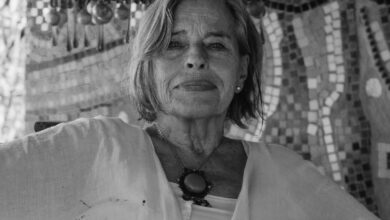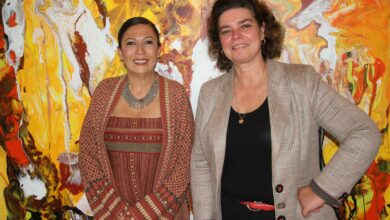Eighty-seven-year-old Herbert Vogel and his wife Dorothy are a retired post office clerk and librarian with a massive collection of contemporary art, which they have been amassing since the 1960s in their rent-stabilized apartment on Manhattan’s Upper East Side.
Quite an atypical profile for art collectors, the Vogels show that art is not always as exclusive as it seems.
Unlike New York, which has an extensive network of galleries, art dealers, academies and a diverse audience, Cairo, despite its long history, has a much smaller art scene and market. Its legacy is related to its Pharaonic heritage rather than its modern and contemporary art movements. The Egyptian art market has, nevertheless, been growing steadily over the past three decades with the opening of new commercial and private galleries as well as increased government investment in the local art scene.
But, the profile of Egyptian art collectors is skewed towards the rich, often encompassing a mixture of the “ancient regime”–older wealthy families from the pre-revolution era–as well as a class of well-to-do that has been growing since the open door policies of former Egyptian President Anwar al-Sadat in the 1970s. In addition to a group of artistic aficionados, many Egyptian art collectors see art as a way to “display wealth, status and knowledge with a touch of culture,” as Egyptian sociologist Mona Abaza writes in her latest book, “Twentieth-Century Egyptian Art: The Private Collection of Sherwet Shafei.”
Shafei, a retired Egyptian television presenter and head of Channel Two (the cultural channel) in the 1980s, became one of the most influential art dealers in Egypt, playing a significant role in shaping the tastes of Egyptian collectors and more recently advising Christie’s auction house in Dubai.
Shefai witnessed the opening of Egyptian universities to the public for the first time in the 1950s. The daughter of a middle class police officer, she graduated from Cairo University’s Faculty of English Literature in 1956. With the establishment of Egyptian Television (ETV) in 1960, Shafei joined the crew, organizing and presenting a weekly TV program with Egyptian painter Salah Taher called "Jawlat al-funun" (Journey Through the Arts). It was under the Nasser regime that Shafei developed an extensive network of artists, critics and writers and acquired her knowledge of modern Egyptian art. By the 1980s, Shafei retired and started working with Roxane Petridis at Zamalek’s Safarkhan, an antiques shop selling woodwork and Islamic artwork, which Shafei turned into a full-fledged art gallery.
In her exclusive “Collectors’ Corner” located right above Safarkhan, Shafei has advised numerous collectors on which artists to follow and pieces to buy, educating them on the artists’ backgrounds and styles. The local art market is thriving, explains Shafei, in tandem with the real estate boom in the 1990s and the construction of numerous private houses in satellite cities as well as beach resorts along the Mediterranean and Red Seas. “It is clear that the younger generation wants to furnish its salons with Egyptian painters… they are in great demand today,” explains Shafei in the book. This encouraged Shafei to open an extension to Safarkhan gallery a few years ago in the lavishly constructed al-Gouna beach resort on the Red Sea.
“Twentieth-Century Egyptian Art” is based on numerous interviews and meetings with Shafei, which Abaza started in 2004 while working on her previous book, “The Changing Consumer Culture of Modern Egypt, Cairo’s Urban Reshaping.” Shafei suggested that Abaza write a book about Safarkhan’s seminal collection, which includes paintings and sculptures from the late nineteenth and early twentieth centuries, in addition to a selection of works by Orientalist painters and the European expatriate community in Egypt, who, Abaza explains, helped shaped the image of Egypt on both the local and international scenes.
Shafei acquired her first painting in the mid 1980s–Hamed Nada’s “Night and Day” for LE1,500– and the first art exhibition at Safarkhan was in the late 1980s. An exhibition of the works of the two Egyptian pioneers Hamed Nada and Ragheb Ayad was, however, what launched Shafei’s career. Within two decades the collection expanded to include over 250 artworks including those by Mahmoud Mokhtar and Mahmoud Sa’id, Mohamed Naghy, Youssef Kamel, el-Hussein Fawzi, Hamed Abdallah, Efat Naghy and Georges Sabbagh.
In addition to 200 illustrated pages of the collection with Shafei’s notes providing formal analysis of the artwork, artistic trends, as well as some contextual information, the book provides great insights about the social, economic, and cultural conditions that nurtured the growth of the art market in Egypt. The free market policies of the Sadat and Mubarak regimes led to the growth of a social class which Abaza compares to the early American “capitalist tycoons,” such as the Fords or the Rockefellers. The increased integration of Egypt into the world economy also “fostered a new culture of luxury, leisure and lifestyle,” explains Abaza.
Tourism also played a significant role in vitalizing the Egyptian art market. It highlighted the value of Islamic and Egyptian artifacts as “authentic indigenous traditions.” Five-star hotels that have been mushrooming across the metropolis have been putting together massive collections of modern Egyptian art, stimulating the interest of their residents. Shafei cited numerous clients, who approached her after seeing paintings of Egyptian pioneers in the hallways of the Four Seasons Hotel.
Abaza adds that there’s been an increasing interest in Islamic and Bedouin home décor, mashrabeyas, arabesque and the like, which she describes as a process of “orientalizing the Orientals.” A whole genre of magazines such as Obelisque and Al-Beit has flourished over the past few years, catering to the needs of this growing social class and advising them on good taste and how to furnish their homes.
Despite rising poverty and a global financial crisis, at the time of the book’s publication, the Egyptian art market continued to grow. Several commercial art galleries have opened over the past years, like Tache gallery in the upscale 6th of October City’s Designopolis and several others are planning to open this year.
Egyptian Artists believe that the new commercial galleries will have a positive effect on the local art market, enhancing the sales value of their work, which is much lower than other Arab artists. “Commercial galleries play a key role in promoting local artists and their work,” explains Egyptian collector Fatenn Mostafa. Their greatest value, however, will be in their ability to “discover and sponsor new talents,” she adds.
“We have a decent collectors’ base,” explains Mostafa, who says they need to be encouraged to acquire the works of young and contemporary artists.
So far, most commercial galleries have been playing it safe, exhibiting established artists with marketable works. Mostafa attributes this to the large investment it requires for galleries to promote “upcoming artists.”
Shafei’s Safarkhan is best known for promoting the works of the Egyptian pioneers and rediscovering some important artists that weren’t recognized commercially before. She has only recently started to bring in new blood by occasionally exhibiting the works of younger graduates of the American University in Cairo's Faculty of Fine Arts. The sustainability of such efforts and those of others will show the impact commercial galleries might have on the local art scene.




